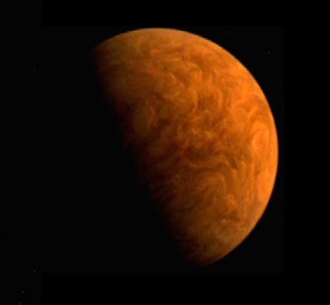
A gas giant is a huge planet made entirely of base gases, including hydrogen, helium, methane and ammonia. Typically they do not posses a clearly distinguishable solid surface, but rather have dense atmospheres. These turbulent atmospheres are generally made of the same materials as stars, however, they lack the mass necessary to begin nuclear fusion. There are four gas giants in our Solar System: Jupiter, Saturn, Uranus, and Neptune. Many extrasolar gas giants have been identified orbiting other stars.
Several types of gas giants were encountered Star Trek. In the Star Trek:The Next Generation episode "Ship in a Bottle", the USS Enterprise-D was able to witness the collision of two gas giants in the Detrian system. In another episode, "Interface", the USS Raman (captained by Geordi La Forge's mother) became trapped in the atmosphere of a gas giant while the crew was attempting to sample it at a low orbit. In the Star Trek: Enterprise episode "Broken Bow", the Enterprise pursues a Suliban ship into the atmosphere of a gas giant and hid in the planet's layer of liquid phosphorus when attacked.

The gas giant encountered in "Broken Bow"
Gas giants can be subdivided into different types. The "traditional" gas giants, Jupiter and Saturn, are composed primarily of hydrogen and helium. Uranus and Neptune are sometimes considered a separate subclass called ice giants, as they are mostly composed of water, ammonia, and methane; the hydrogen and helium in Uranus and Neptune is mostly in the outermost region. Among extrasolar planets, Hot Jupiters are gas giants that orbit very close to their stars and thus have a very high surface temperature. Due to the relative ease of detecting them, Hot Jupiters are currently the most common form of extrasolar planet known. The nearest known gas giant to our solar system orbits the nearby star Epsilon Eridani, located 10.5 light-years away.


Jupiter